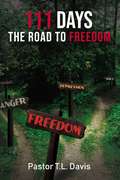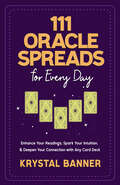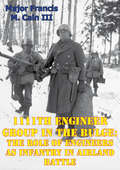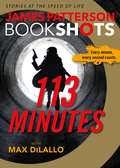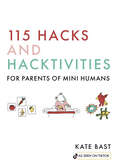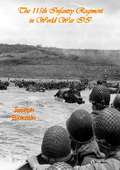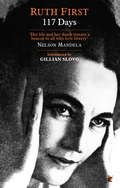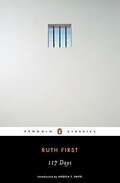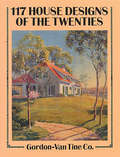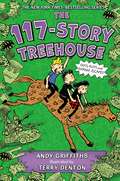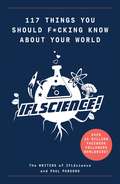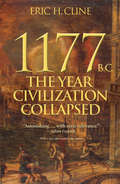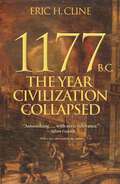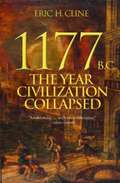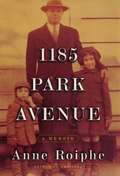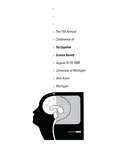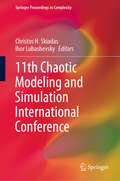- Table View
- List View
1105 Yakima Street: 74 Seaside Avenue; 8 Sandpiper Way; 92 Pacific Boulevard; 1022 Evergreen Place; 1105 Yakima Street; 1225 Christmas Tree Lane (Cedar Cove #Bk. 11)
by Debbie Macomber1105 Yakima SreetCedar Cove, WashingtonDear Reader,You’ve probably heard that my wife has left me. Rachel’s pregnant, and she says she can’t handle the stress in our household anymore. My thirteen-year-old daughter, Jolene, is jealous of her. Maybe it’s my fault. As a widower I spoiled her—Jolene was reading over my shoulder just now and says that’s not true. She claims Rachel ruined everything. But that’s not true. The real question is: How can I get my wife back? I don’t even know where she is. She’s not with Teri Polgar or any of her other friends from the salon. The other question is…when will Jolene grow up and stop acting like such a brat?Of course, I’m not the only one in town with problems. Linc Wyse’s father-in-law is trying to destroy his business. And you know Charlotte Rhodes? Seems she’s becoming forgetful, and the family’s worried about her and Ben. Lots of other stuff going on—but Rachel is better at keeping up with it than I am.If you have any idea where my wife is, give me a call. Please.Bruce Peyton
1105 Yakima Street (Cedar Cove #11)
by Debbie Macomber#1 New York Times bestselling author Debbie Macomber weaves a tale of love and parenthood, as newlyweds struggle with blending families in this classic novel.1105 Yakima SreetCedar Cove, WashingtonDear Reader,You&’ve probably heard that my wife has left me. Rachel&’s pregnant, and she says she can&’t handle the stress in our household anymore. My thirteen-year-old daughter, Jolene, is jealous of her. Maybe it&’s my fault. As a widower I spoiled her—Jolene was reading over my shoulder just now and claims Rachel ruined everything. But that&’s not true. The real question is: How can I get my wife back? I don&’t even know where she is. She&’s not with Teri Polgar or any of her other friends from the salon. The other question is…when will Jolene grow up and stop acting like such a brat?Of course, I&’m not the only one in town with problems. Linc Wyse&’s father-in-law is trying to destroy his business. And you know Charlotte Rhodes? Seems she&’s becoming forgetful, and the family&’s worried about her and Ben. Lots of other stuff going on—but Rachel is better at keeping up with it than I am.If you have any idea where my wife is, give me a call. Please.Bruce Peyton Previously published.
111 Calculation Exercises in the Field of Chemical Technology
by Günter JüptnerEveryday use in chemical production operations requires a complex bundle of basic knowledge for calculating various operating parameters and variables. This includes the application of mass and heat balances, the ideal gas law, the mass action law and electrochemistry. In addition, there are calculations for the pumping of liquids and for scale enlargement. The present work covers this subject area in a clear manner in the form of exercises. The author knows from many years of practical experience that such calculations are often not isolated problems, but complex issues in which various subject areas are coupled together. This fact is taken into account in this exercise book. It presents in a short and concise form the everyday challenges of calculations in a chemical plant and offers ways of solving them. Special basic operations are not treated, and reference is made to special works that treat such topics in detail. This exercise book offers the possibility of deepening the knowledge of solving the calculations that occur daily in a chemical production plant.
111 Days: The Road to Freedom
by T. L. DavisForget the 12-step plan to deliverance or the, if you do what I do you will have what I have plans that take our money and we see no results. 111 Days: The Road to Freedom will change your way of thinking about deliverance and healing in a way that is practical and attainable through prayer and work. Not for the faint at heart because of the subject matter, but it deals with an issue that the church has failed to address. The issue affects men and women and the outlets for help are little to none because the behavior is viewed as normal or acceptable by society.This brief book will take you through a journey that explains how the writer himself overcame the addiction to pornography and where it came from and how to fight for your own deliverance. Pastor Davis comes out of hiding to expose the enemy that is lurking in our homes, businesses, and churches.Your freedom starts right here but it’s all up to you to stay on the road.
111 Oracle Spreads for Every Day: Enhance Your Readings, Spark Your Intuition, & Deepen Your Connection with Any Card Deck
by Krystal BannerThis first-of-its-kind book of 111 oracle card spreads is separated into common topics—general, love, career, spiritual, and astrology—and offers readers creative, magical ways to work with their intuition and their favorite oracle deck to find guidance and inner wisdom.Practical, insightful, and magic-infused spreads for oracle card deck readers at any point in their journey with divination: from seasoned pros to newbie readers learning to read using their first deck.The book is not connected to a particular deck, but like books of tarot spreads, it is something any oracle reader can use: from the seeker who has just purchased their first deck to someone who has a collection of decks piled up to their ceiling.Some examples include: the Attraction Spread, which helps the reader sort through what energies they are attracting both consciously and subconsciously; the Spirit Guide Spread, which calls in messages from the reader's guides; and the Mercury Retrograde Spread, which encourages the reader to reflect on the challenges and opportunities in this unsettled period.
1111th Engineer Group In The Bulge: The Role Of Engineers As Infantry In Airland Battle
by Major Francis M. Cain IIIThis study examines the role of U.S. Army Engineers fighting as infantry in AirLand Battle by analyzing the actions of the 1111th Engineer Combat Group during the Battle of the Bulge in Dec. 1944. By manning hasty defensive positions at Malmedy, Stavelot, and Trois Ponts, the 291st Engineers and C Company, 51st Engineers delayed the German advance long enough for 30th Infantry and 82d Airborne Divisions to reach the area and wrestle the initiative from Sixth Panzer Army. The defense of the Ourthe River line by elements of the 51st Engineers was instrumental in delaying 116th Panzer Division long enough for 3rd Armored and 84th Infantry Divisions to reach defensive positions in front of the Meuse River.Engineers were successful as infantry against mechanized forces for several reasons: 1) Infantry missions were limited in scope; 2) They were augmented with additional fire power; 3) They occupied good defensible terrain; 4) World War II engineer units received extensive combat training before deploying overseas.The Battle of the Bulge displays many of the characteristics of a Soviet attack on NATO. Like the Ardennes in Dec. 1944, NATO's Central Front is held by units which are overextended, untested in combat, and locked into a rigid forward defense with limited tactical reserves and no operational reserves. Under these circumstances, if Soviet forces do penetrate the Main Battle Area, engineer units are likely to be committed as infantry to block or contain the penetration. Like the Battle of the Bulge, we can expect a non-linear battlefield with fragmented, isolated units-a battlefield dominated by confusion and uncertainty. It is in exactly this type of situation that the actions of a few brave, determined men can make the difference between victory and defeat. By manning small, isolated defensive positions, the men of the 1111th Engineer Group provided the extra measure of combat power that tipped the scales of victory in favor of the Allies in Dec. 1944.
112 Miles to the Pin: Extreme Golf Around the World
by Duncan LennardFor many golfers, the innocent thrill of striking a drive clearly, avoiding a deep sand-trap, or holing out an unlikely putt is all they need to make a round (or a whole year) of golf memorable. But there's a group of modern players in search of something more. They've rediscovered the magic of the game in "extreme" golf, and their adventures are about to inspire golfers everywhere. Here are players like Andre Tolme, who decided to turn Mongolia into a par 11,880 course and Torsten Schilling, who spends his weekends teeing off from the side of his boat aiming for sites back on shore. From New Zealand's naked open to golf in Antarctica, Duncan Lennard describes a world at the very edge of the sport.
113 Minutes (BookShots)
by James Patterson Max Dilallo<P>I know who killed my son. <P>Molly Rourke's son has been murdered... <P>And she knows who's responsible. Now she's taking the law into her own hands. Never underestimate a mother's love. <P><b>A New York Times Bestseller</b>
1133 Questions: An Interventional Cardiology Board Review
by Debabrata Mukherjee David Moliterno Leslie Cho Richard Lange Saurav ChatterjeePublisher's Note: Products purchased from 3rd Party sellers are not guaranteed by the Publisher for quality, authenticity, or access to any online entitlements included with the product. With two new editors and hundreds of new questions, this comprehensive new edition of 1133 Questions: An Interventional Cardiology Board Review, continues to serve as the perfect study aid for anyone taking the American Board of Internal Medicine (ABIM) interventional cardiology board exam, either for the first time or to recertify. You’ll have everything you need—detailed answers and explanations for each question and plenty of relevant images—to pass the exam and improve your ability to provide effective and evidence-based patient care.
115 Hacks and Hacktivities for Parents of Mini Humans
by Katherine BastWhen you have a mini human running around, things can get pretty messy. Public diaper blowouts, shopping tantrums, teething pain, art projects that end up on the wall—and that&’s only the tip of the iceberg. But don&’t worry! 115 Hacks and Hacktivities for Parents of Mini Humans has all the tips and tricks for big humans on the verge of their own tantrums. With hacks for everything from mini human care to travel and toys, this book will give you the extra hand you need to do it all. Divided into helpful categories, each innovative hack comes with easy-to-follow instructions, materials made up of simple items you can find in your own home or local stores, and clean, modern illustrations that make parenting feel a little less hectic (even on the days that you are running on fumes). And watch out for the hacktivities! You can use these hacks that are disguised as activities to keep your mini human busy, making parenting fun for everyone. In a durable and easy-to-carry package, this must-have book can go with you anywhere. Parenting is officially hacked!
The 115th Infantry Regiment in World War II
by Joseph Binkoski Arthur PlautOn 3 February 1941, the First Maryland Infantry Regiment, Maryland Army National Guard, was inducted into federal service as the 115th Infantry Regiment and sent to join the 29th Infantry Division. They arrived in England on 11 October 1942, and then were attached to the 1st Infantry Division in preparation for the D-Day invasion. They moved with the 1st Infantry Division from 2 June 1944, and remained with 1st Infantry Division until 7 June 1944, when they returned to the 29th Infantry Division for further operations. Their participation in the Normandy Campaign continued until it was over on 24 July 1944. They immediately moved into the Northern France Campaign on 25 July 1944, which continued until it was over on 14 September 1944.During this period the 115th Infantry Regiment was engaged in one of the war's forgotten chapters, "The Battle of Brest". The Battle for Brest was one of the fiercest battles fought during Operation Cobra, the Allied breakout of Normandy which began on 27 July 1944, during the Battle of Normandy during World War II. The 115th Infantry then started participation in the Rhineland Campaign on 15 September 1944, whereupon the 115th Infantry crossed from France to Belgium and the Netherlands both on 27 September 1944, and entered Germany on 30 September 1944.
117 Days: An Account of Confinement and Interrogation under the South African 90-Day Detention Law (Vmc Ser. #483)
by Ruth FirstIn prison you see only the moves of the enemy. Prison is the hardest place to fight a battle.'117 Days is Ruth First's personal account of her detention under the iniquitous '90-day' law of 1963. There was no warrant, no charge and no trial - only suspicion.This sparsely written and unique record tells of her experiences of solitary confinement, constant interrogation and instantaneous re-arrest on release - lightened by humorous portraits of governors, matrons, wardresses and interrogators, seen as the tools of the police state.
117 Days: An Account of Confinement and Interrogation under the South African 90-Day Detention Law (Virago Modern Classics #139)
by Ruth FirstIn prison you see only the moves of the enemy. Prison is the hardest place to fight a battle.'117 Days is Ruth First's personal account of her detention under the iniquitous '90-day' law of 1963. There was no warrant, no charge and no trial - only suspicion.This sparsely written and unique record tells of her experiences of solitary confinement, constant interrogation and instantaneous re-arrest on release - lightened by humorous portraits of governors, matrons, wardresses and interrogators, seen as the tools of the police state.
117 Days
by Ruth FirstIn August 1963 Ruth First was arrested and detained in solitary confinement under the 90-Day Law for a total period of 117 days, following arrests of members of the underground ANC. The book tells about the 117 days.
117 House Designs of the Twenties (Dover Architecture)
by Gordon-Van Tine Co.In the post-World War I era, as the economic boom of the 1920s gathered momentum, millions of Americans set out to make the dream of owning their own home come true. Labor and materials were plentiful and cheap, and new trends in home design made the prospect of homebuilding an exciting venture. This fascinating book, a reprint of a rare catalog of prefabricated houses from 1923, reveals in detail the types of design offered to those in the market for a new home in the early 1920s.Of the 117 designs included, most are substantial middle-class homes. But the popularity of cottages and bungalows is also apparent in the wide selection of practical and appealing designs depicted. And there are large, formal homes as well, many of which embody America's unflagging interest in colonial styling. Some have affluent touches such as a sleeping porch or a sun room. Many reflect a strong interest in exterior detailing, in the form of cypress siding, broad eaves, heavy timber brackets, stucco pillars, and flower boxes, among other features.Each house is shown in a large frontal illustration. Floor plans for the first and second floors are included, and interior and exterior detailing are extensively described. The specifics of plumbing, heating, and lighting are included in a special section at the back of the book.Architects, architectural and social historians -- anyone interested in American home design -- will enjoy the rich variety of designs presented. Republished in association with the Athenaeum of Philadelphia, this authentic catalog provides not only an indispensable repository of information about the homes themselves but a source of insight into American life at a time when owning a home became a widely realizable dream for a rapidly growing middle class.
The 117-Story Treehouse: Dots, Plots & Daring Escapes! (The Treehouse Books #9)
by Andy GriffithsNew York Times-bestselling team Andy Griffiths and Terry Denton invite readers to come hang out with them in their 117-Story Treehouse—the ninth book in the illustrated chapter book series filled with Andy and Terry's signature slapstick humor!Andy and Terry live in a 117-story treehouse. (It used to be a 104-story treehouse, but it just keeps growing!) It now has a pajama-party room, a water-ski park filled with flesh-eating piranhas, an Underpants Museum, a giant-fighting-robot arena, and the Door of Doom (don’t open it or you’ll be COMPLETELY and UTTERLY DOOMED!).For as long as Andy and Terry have been writing books together, Andy has always been the narrator and Terry has always been the illustrator. But when Terry tries to prove that he can narrate as well as draw, the story goes completely out of control and the Story Police arrive to arrest the whole treehouse team for crimes against storytelling! Andy, Terry and Jill go on the run, but how long can they evade the Story Police and stay out of Story Jail? Praise for Andy Griffiths and the Treehouse series:"Anarchic absurdity at its best. . . . Denton's manic cartooning captures every twist and turn in hilarious detail." —Publishers Weekly, starred review, on The 13-Story Treehouse"Will appeal to fans of Jeff Kinney and Dav Pilkey. . . . The wonderfully random slapstick humor is tailor-made for reluctant readers. . . . A treat for all." —Booklist on The 13-Story TreehouseRead the whole series!The 13-Story TreehouseThe 26-Story TreehouseThe 39-Story TreehouseThe 52-Story TreehouseThe 65-Story TreehouseThe 78-Story TreehouseThe 91-Story TreehouseThe 104-Story TreehouseThe 117-Story Treehouse
117 Things You Should F*#king Know About Your World: The Best of IFL Science
by IflscienceDid you know your irises are lying to you and all human eyes are actually brown?Want to know the absolute worst way to die, according to science? Did you know that a smoking psychedelic toad milk could alleviate depression for up to four weeks?117 Things You Should F*#king Know About Your World tells you the answers to these questions and many more weird and wonderful facts about the universe. Split into the site's different subject areas of environment, technology, space, health and medicine, plants and animals, physics and chemistry, this is the ultimate science book. With 25 million social media followers, I F*#king Love Science is the world's favourite source of science on the web. From missing nuclear weapons and Facebook secret files to the world's smallest computer and why you should wrap your car keys in tinfoil, this is the book that only the world's leading source of crazy-but-true stories could produce.
1177 B.C.: The Year Civilization Collapsed (Turning Points in Ancient History)
by Eric H. ClineIn 1177 B.C., marauding groups known only as the "Sea Peoples" invaded Egypt. The pharaoh's army and navy managed to defeat them, but the victory so weakened Egypt that it soon slid into decline, as did most of the surrounding civilizations. After centuries of brilliance, the civilized world of the Bronze Age came to an abrupt and cataclysmic end. Kingdoms fell like dominoes over the course of just a few decades. No more Minoans or Mycenaeans. No more Trojans, Hittites, or Babylonians. The thriving economy and cultures of the late second millennium B.C., which had stretched from Greece to Egypt and Mesopotamia, suddenly ceased to exist, along with writing systems, technology, and monumental architecture. But the Sea Peoples alone could not have caused such widespread breakdown. How did it happen?In this major new account of the causes of this "First Dark Ages," Eric Cline tells the gripping story of how the end was brought about by multiple interconnected failures, ranging from invasion and revolt to earthquakes, drought, and the cutting of international trade routes. Bringing to life the vibrant multicultural world of these great civilizations, he draws a sweeping panorama of the empires and globalized peoples of the Late Bronze Age and shows that it was their very interdependence that hastened their dramatic collapse and ushered in a dark age that lasted centuries.A compelling combination of narrative and the latest scholarship, 1177 B.C. sheds new light on the complex ties that gave rise to, and ultimately destroyed, the flourishing civilizations of the Late Bronze Age--and that set the stage for the emergence of classical Greece.
1177 B.C.: The Year Civilization Collapsed: Revised and Updated (Turning Points in Ancient History #2)
by Eric H. ClineA bold reassessment of what caused the Late Bronze Age collapseIn 1177 B.C., marauding groups known only as the "Sea Peoples" invaded Egypt. The pharaoh's army and navy managed to defeat them, but the victory so weakened Egypt that it soon slid into decline, as did most of the surrounding civilizations. After centuries of brilliance, the civilized world of the Bronze Age came to an abrupt and cataclysmic end. Kingdoms fell like dominoes over the course of just a few decades. No more Minoans or Mycenaeans. No more Trojans, Hittites, or Babylonians. The thriving economy and cultures of the late second millennium B.C., which had stretched from Greece to Egypt and Mesopotamia, suddenly ceased to exist, along with writing systems, technology, and monumental architecture. But the Sea Peoples alone could not have caused such widespread breakdown. How did it happen?In this major new account of the causes of this "First Dark Ages," Eric Cline tells the gripping story of how the end was brought about by multiple interconnected failures, ranging from invasion and revolt to earthquakes, drought, and the cutting of international trade routes. Bringing to life the vibrant multicultural world of these great civilizations, he draws a sweeping panorama of the empires and globalized peoples of the Late Bronze Age and shows that it was their very interdependence that hastened their dramatic collapse and ushered in a dark age that lasted centuries.A compelling combination of narrative and the latest scholarship, 1177 B.C. sheds new light on the complex ties that gave rise to, and ultimately destroyed, the flourishing civilizations of the Late Bronze Age—and that set the stage for the emergence of classical Greece.
1177 B.C.
by Eric H. ClineIn 1177 B.C., marauding groups known only as the "Sea Peoples" invaded Egypt. The pharaoh's army and navy managed to defeat them, but the victory so weakened Egypt that it soon slid into decline, as did most of the surrounding civilizations. After centuries of brilliance, the civilized world of the Bronze Age came to an abrupt and cataclysmic end. Kingdoms fell like dominoes over the course of just a few decades. No more Minoans or Mycenaeans. No more Trojans, Hittites, or Babylonians. The thriving economy and cultures of the late second millennium B.C., which had stretched from Greece to Egypt and Mesopotamia, suddenly ceased to exist, along with writing systems, technology, and monumental architecture. But the Sea Peoples alone could not have caused such widespread breakdown. How did it happen?In this major new account of the causes of this "First Dark Ages," Eric Cline tells the gripping story of how the end was brought about by multiple interconnected failures, ranging from invasion and revolt to earthquakes, drought, and the cutting of international trade routes. Bringing to life the vibrant multicultural world of these great civilizations, he draws a sweeping panorama of the empires and globalized peoples of the Late Bronze Age and shows that it was their very interdependence that hastened their dramatic collapse and ushered in a dark age that lasted centuries.A compelling combination of narrative and the latest scholarship, 1177 B.C. sheds new light on the complex ties that gave rise to, and ultimately destroyed, the flourishing civilizations of the Late Bronze Age--and that set the stage for the emergence of classical Greece.
1185 Park Avenue
by Anne RoipheIn this captivating memoir, Anne Roiphe revisits the world of her childhood, which was spent growing up in a rich, Jewish family who resided in New York during the 1940's and 1950's. Through her eyes, we witness the atrocities of her unfaithful father, the miseries of her insecure mother and the sufferings of her sickly brother, who eventually meet their end in different, tragic ways and leave her alone to deal with painful memories of the past.
11th Annual Conference Cognitive Science Society Pod
by Cognitive Science Cognitive Science SocietyFirst published in 1989. This Program discusses The Eleventh Annual Conference of the Cognitive Science Society, August 1989 in Ann Arbor, Michigan. The book begins with 66 paper presentations and concludes with 59 poster presentations across over 1000 pages. This program also includes a comprehensive author listing with affiliations and titles.
11th Asian-Pacific Conference on Medical and Biological Engineering: Proceedings of the Online Conference APCMBE 2020, May 25-27, 2020 (IFMBE Proceedings #82)
by Yasuyuki Shiraishi Ichiro Sakuma Keiji Naruse Akinori UenoThis book presents cutting-edge research and developments in the field of medical and biological engineering, which a special emphasis on activities carried out in the Asian-Pacific region. Gathering the proceedings of the 11th Asian-Pacific Conference on Medical and Biological Engineering, organized in Japan and held online on May 25-27, 2020, the book both fundamental research and clinical applications relating to medical instrumentations, bioimaging, bioinformatics and computational biomedicine, AI and data science in healthcare, as well as regenerative medicine and rehabilitation. It aims at informing on new trends, challenges and solutions, and fosters communication and collaboration between medical scientists, engineers, and researchers dealing with cutting-edge themes in broad field of biomedical and clinical engineering.
11th Chaotic Modeling and Simulation International Conference (Springer Proceedings in Complexity)
by Christos H. Skiadas Ihor LubashevskyGathering the proceedings of the 11th CHAOS2018 International Conference, this book highlights recent developments in nonlinear, dynamical and complex systems. The conference was intended to provide an essential forum for Scientists and Engineers to exchange ideas, methods, and techniques in the field of Nonlinear Dynamics, Chaos, Fractals and their applications in General Science and the Engineering Sciences. The respective chapters address key methods, empirical data and computer techniques, as well as major theoretical advances in the applied nonlinear field. Beyond showcasing the state of the art, the book will help academic and industrial researchers alike apply chaotic theory in their studies.
The 11th Georgia Volunteer Infantry Regiment 1861–1865: A Biographical Roster
by Richard Michael AllenThe 7th, 8th, 9th, and 11th Georgia volunteer infantry regiments spent most of the Civil War fighting under Brig. Gen. George Thomas “Tige” Anderson in Gen. Robert E. Lee’s Army of Northern Virginia. Until now, no biographical roster of their members has ever been published. These Georgians saw it all, from the bloody battle of First Manassas through the ferocious combat of Second Manassas, Sharpsburg, Gettysburg, the Wilderness, Spotsylvania, and the long siege of Petersburg. They finally furled their banners at Appomattox. Nearly 5,000 men passed through these four Georgia regiments. These rosters offer a long overdue record of these men. Each roster is organized by company in a simple and easy to use format. Entries feature full names (if known), promotions, demotions, casualties, transfers, and resignations for every rank—an unprecedented look into men and the structure and evolution of these organizations. They include the most comprehensive examination of the personnel originally enlisted and their subsequent service histories within these units in chronological order for the first time. Compiler and author Richard Allen has spent nearly two decades researching scores of archives and other sources to prepare these rosters. He utilized primary sources such as the Official Records, Compiled Service Records, newspaper accounts, diaries, letters, census information, burial records, and a variety of documents from both published sources and private collections. Students of the Civil War, genealogists, and enthusiasts of Georgia history will find these rosters invaluable. Everyone who uses them owes Rick Allen a hearty, and heartfelt, thank you.



